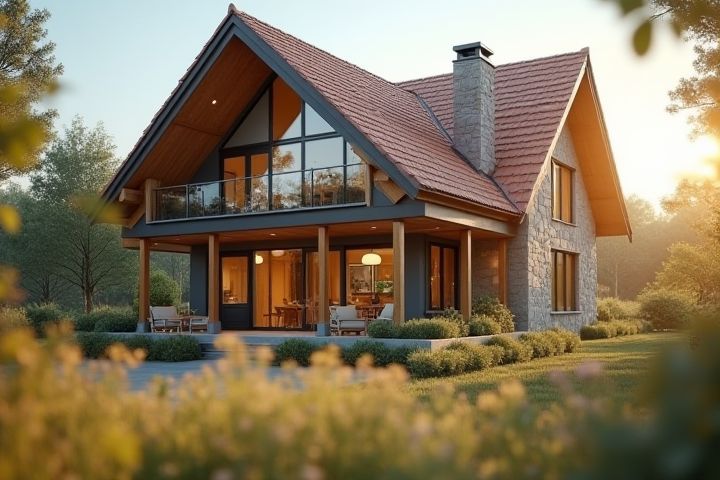
A house can achieve energy efficiency through various strategies, including the installation of energy-efficient appliances, LED lighting, and proper insulation that reduces heat loss or gain. Utilizing renewable energy sources, such as solar panels or wind turbines, can significantly lower your carbon footprint while providing sustainable power. Smart home technology allows for better control of energy consumption through automated systems that optimize heating, cooling, and lighting based on your usage patterns. Additionally, choosing energy-efficient windows and doors minimizes air leaks and enhances thermal performance. Making these upgrades not only conserves energy but also lowers utility bills and increases the overall comfort of your living space.
Can A House Be Energy-Efficient
Insulation quality.
Insulation quality is crucial in making a house energy-efficient, as it significantly reduces heat loss during winter and heat gain in summer. High-performance insulation materials, such as spray foam or cellulose, have an R-value ranging from 3.5 to 6.5 per inch, effectively minimizing the energy required for heating and cooling. Proper installation of insulation in walls, attics, and floors creates a thermal barrier, translating to potential energy savings of up to 30% on utility bills. Ensuring that your home meets local building codes regarding insulation can lead to enhanced indoor comfort and reduced environmental impact over time.
Energy-efficient windows.
Energy-efficient windows are crucial for enhancing a home's energy efficiency, as they can reduce heating and cooling costs by up to 25%. Features such as double or triple glazing and low-emissivity (low-E) coatings play a significant role in minimizing heat transfer, keeping your home comfortable year-round. Additionally, ENERGY STAR-rated windows can provide an average savings of $126 to $465 annually on energy bills, depending on your climate. By investing in high-quality, energy-efficient windows, you will not only improve your home's comfort but also contribute to a more sustainable environment.
LED lighting.
LED lighting significantly enhances energy efficiency in homes, using up to 75% less energy than traditional incandescent bulbs. With a lifespan of approximately 25,000 hours, LEDs can last over 25 times longer, reducing replacement costs and waste. Switching to LED bulbs can cut your lighting energy expenses by nearly 80%, enabling substantial savings on utility bills. By investing in LED technology, homeowners not only boost energy efficiency but also contribute to environmental sustainability.
Solar panel installation.
Installing solar panels can significantly enhance a house's energy efficiency, with potential savings of 20-50% on electric bills. In 2023, the average cost of solar panel installation ranges from $15,000 to $25,000, often providing a return on investment within 5 to 10 years. Solar energy systems can offset carbon emissions by approximately 100 tons over their lifetime, contributing to a more sustainable environment. By harnessing sunlight, you not only reduce energy costs but also increase your home's value, as properties with solar installations typically fetch 4.1% more on the market.
High-efficiency HVAC systems.
High-efficiency HVAC systems significantly enhance a house's energy efficiency by utilizing advanced technology to optimize heating and cooling. These systems often feature variable-speed motors, which adjust airflow based on real-time temperature needs, reducing energy consumption. Installing a high-efficiency model can lead to substantial savings on utility bills while also promoting a more comfortable indoor environment. When combined with proper insulation and smart thermostats, your home's overall energy efficiency can improve dramatically, resulting in a smaller carbon footprint.
Smart thermostats.
Smart thermostats can significantly enhance a house's energy efficiency by optimizing heating and cooling systems based on your schedule and preferences. For example, models like the Nest Learning Thermostat can learn your routines and adjust temperatures accordingly, potentially saving up to 15% on heating and cooling bills annually. By utilizing features such as geofencing, these devices can sense when you leave or return home, ensuring energy isn't wasted. With Wi-Fi connectivity, you can also monitor and control your home's temperature remotely, further maximizing energy savings.
Energy Star appliances.
Energy-efficient houses significantly reduce utility costs and environmental impact by incorporating Energy Star appliances, which are certified to use less energy and water. For instance, Energy Star washing machines use about 25% less energy and 33% less water compared to standard models, saving homeowners approximately $250 over their lifespan. Additionally, Energy Star refrigerator models can consume up to 15% less energy than required by federal standards, translating to further savings. By investing in these high-efficiency appliances, you can enhance your home's energy performance and contribute to a more sustainable future.
Water-saving fixtures.
Integrating water-saving fixtures can significantly enhance your home's energy efficiency, conserving both water and the energy required for heating it. For instance, low-flow showerheads reduce water usage by up to 50%, saving approximately 2.5 gallons per minute compared to standard fixtures. Dual-flush toilets allow you to choose between a full or reduced flush, potentially conserving over 13,000 gallons of water annually for an average household. By prioritizing these efficient installations, you can lower water bills and contribute to a more sustainable environment.
Roof and wall shading.
Energy-efficient homes often feature roof and wall shading as critical design elements. Proper shading can reduce indoor temperatures by up to 20%, significantly lowering cooling costs in warmer climates. Roof overhangs, awnings, or pergolas can block direct sunlight, while strategically placed trees or shrubs provide natural shade, enhancing energy efficiency. Engaging a professional to design these features can ensure that your home maximizes energy savings and comfort throughout the year.
Regular energy audits.
Regular energy audits can significantly enhance your home's energy efficiency, identifying areas where energy loss occurs. Typically, an energy audit involves a comprehensive evaluation of insulation, windows, heating, and cooling systems, and can reduce energy costs by 5-30%. By implementing recommendations from these audits, such as sealing air leaks and upgrading appliances, homeowners can decrease energy consumption and carbon footprint. Investing in routine audits not only supports sustainability but also improves indoor comfort and increases property value.
